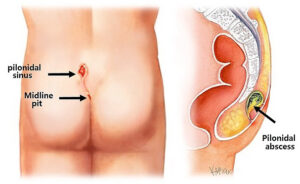First described in 1830, pilonidal sinus, also known as ingrown hair, is a benign skin-subcutaneous disease. It is often seen in the coccyx region and in young patients. It is 2 times more common in men than in women.

How Does Ingrown Hair Occur?
In our patients, there is an enlargement of the hair follicle and neighbouring sweat glands that should not be present at birth. Constant pressure on this area (e.g. prolonged sitting, intense sweating, prolonged driving) causes inflammation of the hair follicle.
With repeated trauma and recurrent infections, hair and tissue residues enter through the enlarged damaged skin in this area. Basically, there is a cavity (nidus) under the skin and a hair (pilus) inside. This is where the name comes from.
What are the Findings in Ingrown Hair?
The most common complaint in patients is swelling, pain and pinhead-sized holes in the area. In case of infection, these findings may be accompanied by redness, temperature increase and discharge.
Ingrown Hair Treatment
When left untreated, an abscess forms. In this case, severe pain, swelling, redness, temperature increase; in severe cases, fever and weakness occur. If there is an abscess, it is necessary to intervene immediately and drain the inflamed fluid in a controlled manner. Frequent recurrent abscesses reduce the success rate of interventions and increase the possibility of infection after the procedure.
In the past, surgery was frequently performed in the treatment of ingrown hair. Nowadays, it is often non-surgical treatments are applied. These methods are phenol therapy, laser therapy and microsinusectomy. There are surgical methods that can be applied when non-surgical treatments are not effective. Although these are rarely needed, the most common and most effective Excision and tissue shifting (flap) technique.
You may also be interested in
Non-Surgical Ingrown Hair Treatment
Haemorrhoidal Disease (Haemorrhoids)



Comment: